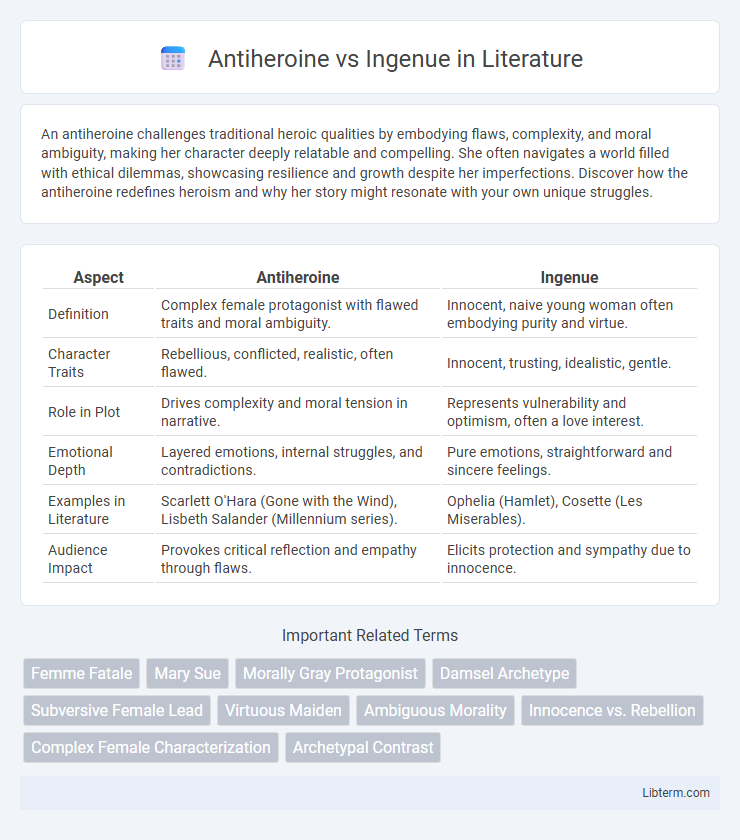An antiheroine challenges traditional heroic qualities by embodying flaws, complexity, and moral ambiguity, making her character deeply relatable and compelling. She often navigates a world filled with ethical dilemmas, showcasing resilience and growth despite her imperfections. Discover how the antiheroine redefines heroism and why her story might resonate with your own unique struggles.
Table of Comparison
| Aspect | Antiheroine | Ingenue |
|---|---|---|
| Definition | Complex female protagonist with flawed traits and moral ambiguity. | Innocent, naive young woman often embodying purity and virtue. |
| Character Traits | Rebellious, conflicted, realistic, often flawed. | Innocent, trusting, idealistic, gentle. |
| Role in Plot | Drives complexity and moral tension in narrative. | Represents vulnerability and optimism, often a love interest. |
| Emotional Depth | Layered emotions, internal struggles, and contradictions. | Pure emotions, straightforward and sincere feelings. |
| Examples in Literature | Scarlett O'Hara (Gone with the Wind), Lisbeth Salander (Millennium series). | Ophelia (Hamlet), Cosette (Les Miserables). |
| Audience Impact | Provokes critical reflection and empathy through flaws. | Elicits protection and sympathy due to innocence. |
Defining the Antiheroine: Complexity in Character
The antiheroine defies traditional female protagonist norms through flawed, morally ambiguous traits that create a multi-dimensional character often torn by internal conflicts. Unlike the ingenue, characterized by innocence and naivety, the antiheroine embodies complexity by challenging societal expectations and embracing vulnerability alongside strength. This nuanced portrayal offers a richer exploration of identity, motivations, and psychological depth that resonates with contemporary audiences seeking realistic, imperfect heroines.
The Ingenue Archetype: Innocence and Idealism
The Ingenue archetype embodies innocence and idealism, often characterized by naivety, purity, and unwavering optimism, which contrasts sharply with the complexity and moral ambiguity typical of the Antiheroine. This archetype symbolizes youthful vulnerability and a hopeful perspective, frequently serving as a narrative foil to more jaded or conflicted characters. Portrayed in literature and film, the Ingenue represents the tension between idealism and harsh reality, making her essential in exploring themes of growth and transformation.
Origins and Evolution of Antiheroines
Antiheroines originated as complex female protagonists who defy traditional heroic qualities, emerging prominently in 20th-century literature and film to challenge established gender roles and narrative conventions. Unlike ingenues, who embody innocence and naivety often linked to early romantic or dramatic roles, antiheroines possess morally ambiguous traits, internal conflicts, and flaws that mirror realistic human experiences. Over time, the antiheroine archetype has evolved through diverse media, reflecting evolving societal attitudes towards female empowerment, autonomy, and multifaceted identities.
The Cultural Roots of the Ingenue
The ingenue archetype originates from early theatrical traditions, embodying innocence, naivety, and youth, often symbolizing purity and virtue in cultural narratives. Rooted in classical literature and opera, the ingenue reflects societal expectations of femininity and submissiveness prevalent in patriarchal societies. This cultural foundation contrasts sharply with the antiheroine, who challenges conventional norms through complexity and moral ambiguity.
Personality Traits: Contrasts and Overlaps
The antiheroine exhibits complex, flawed, and often morally ambiguous traits, challenging traditional notions of heroism with her resilience and pragmatism, while the ingenue is characterized by innocence, naivety, and purity, embodying youthful optimism and vulnerability. Both archetypes navigate conflicts and growth, yet the antiheroine embraces darker internal struggles and self-awareness, contrasting with the ingenue's idealism and emotional openness. Overlaps occur when both display emotional depth and authenticity, highlighting multifaceted female characters beyond simplistic labels.
Narrative Roles and Story Impact
The antiheroine embodies morally complex traits, driving narratives through flawed, relatable decisions that challenge traditional hero archetypes and deepen thematic tension. In contrast, the ingenue represents innocence and naivety, often serving as a catalyst for character growth or emotional stakes within the plot. Both archetypes shape story impact by influencing audience empathy and shaping the trajectory of character development and conflict resolution.
Empowerment and Agency: Who Has the Upper Hand?
The Antiheroine often embodies empowerment through flawed complexity and defiance of traditional norms, asserting agency by challenging societal expectations and making morally ambiguous decisions. In contrast, the Ingenue's empowerment arises from innocence and vulnerability, which can grant subtle influence through authenticity and emotional appeal. While the Antiheroine claims overt control and disruption, the Ingenue wields quiet strength, making the upper hand context-dependent on narrative and character development.
Audience Perception and Popularity
The antiheroine captivates audiences through complex flaws and moral ambiguity, often resonating more deeply due to authentic, relatable struggles and unpredictability. Ingenues attract viewers with innocence and charm, appealing to idealistic or traditional sensibilities but sometimes perceived as less dynamic or multi-dimensional. Popularity tends to favor antiheroines in contemporary media, reflecting a cultural shift toward nuanced characters that challenge conventional heroism and encourage critical audience engagement.
Famous Examples in Literature and Film
The antiheroine often appears in literature and film as complex characters like Lisbeth Salander in "The Girl with the Dragon Tattoo" and Ellen Ripley in "Alien," who challenge traditional moral boundaries and exhibit flawed, relatable traits. In contrast, ingenues such as Ophelia from Shakespeare's "Hamlet" and Belle from Disney's "Beauty and the Beast" embody innocence, naivety, and a gentle demeanor, typically representing purity and virtue. These archetypes highlight distinct narrative roles: the antiheroine drives conflict through rebellion and depth, while the ingenue often symbolizes hope and vulnerability in storytelling.
The Future of Female Archetypes in Media
Antiheroines challenge traditional female archetypes by portraying complex, morally ambiguous characters who defy passive stereotypes, while ingenues represent innocence and naivety often linked to romantic plots. The future of female archetypes in media leans toward nuanced portrayals that blend the boldness of antiheroines with the vulnerability of ingenues, reflecting evolving societal attitudes toward gender roles. Emerging narratives emphasize multi-dimensional women whose traits transcend simplistic categories, fostering diverse and authentic representation.
Antiheroine Infographic

 libterm.com
libterm.com